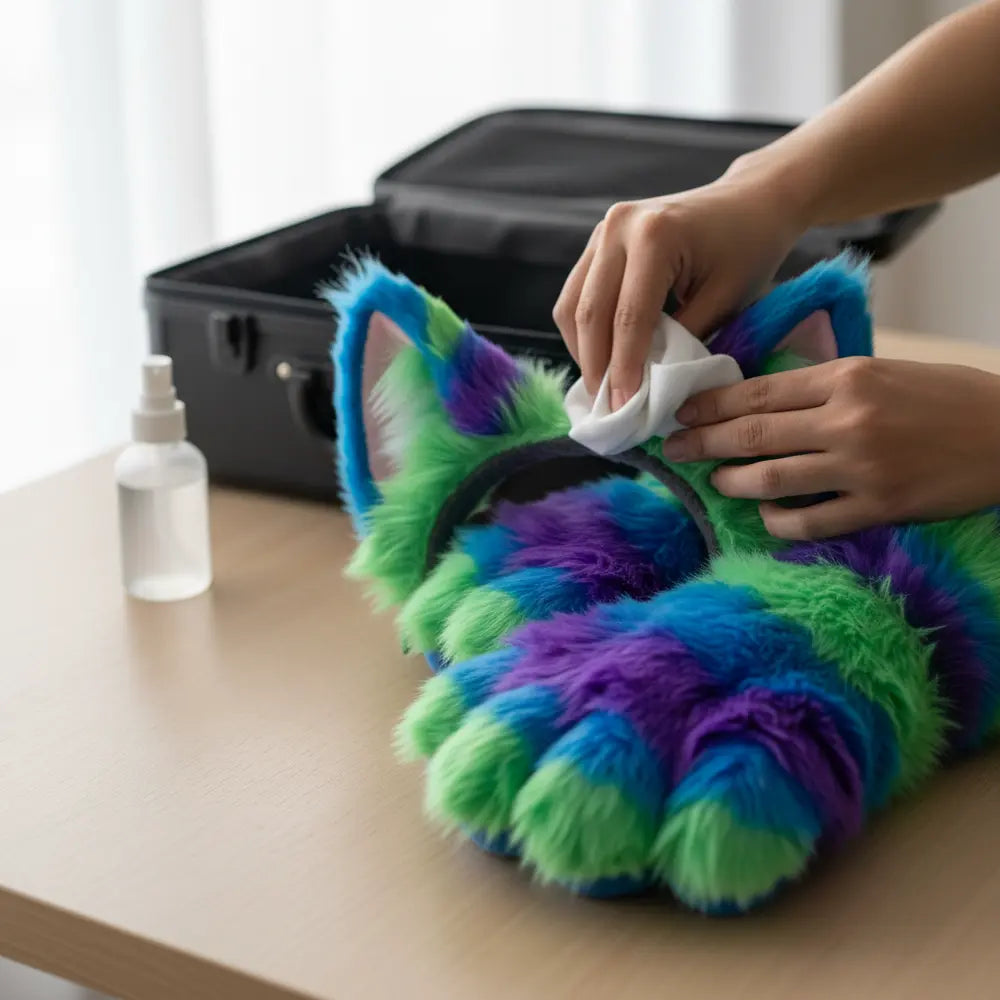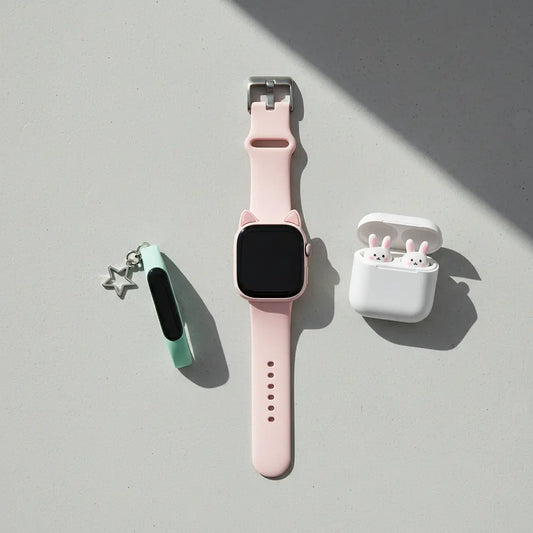
Fursuit Accessories Care & Travel Guide
Fursuit Accessories Care & Travel Guide
You’ve spent months, maybe even years, saving and planning for your dream fursuit accessories. The custom ears are perfectly airbrushed, and the tail has just the right bounce. Then, disaster strikes: a careless coffee spill the night before a big convention, and suddenly, panic sets in. That beautiful, expensive gear now looks stained and sad.
This feeling is all too common in the furry community. Your gear is more than just a costume; it's an investment of money, time, and personal expression. The stress of potentially damaging it is real. But protecting that investment doesn’t have to be a source of anxiety.
Community Poll
What’s your biggest furry gear struggle?
This guide provides practical, expert-vetted solutions for keeping your gear in top shape. We'll cover everything from how to clean furry costume gear safely to simple paw pad repair and genius travel hacks. Consider this your go-to resource for long-term fursuit accessories maintenance.
Why Fursuit Accessories Require Special Care
Ever look at your custom ears and wonder why they can't just be tossed in the wash like a t-shirt? This section explains exactly why your specialized gear needs dedicated care to protect your investment and ensure it lasts for years.
The first step in proper care is understanding what makes your accessories so unique. Unlike off-the-shelf costumes, custom furry gear is often handmade art. A single tail can represent over 40 hours of a maker's labor, combining multiple materials that react differently to cleaning and stress. Treating them with care is essential.
These pieces are built from a mix of materials. The core might be lightweight upholstery foam for structure, while the outside is covered in delicate, multi-toned faux fur. Add to that vinyl for paw pads, plastic for claws, and even complex electronics for movement, and you have a complex item that requires specific handling.
Ignoring this complexity is the fastest way to ruin your gear. Neglect leads to deeply matted fur that can't be brushed out, persistent odors from sweat and bacteria, and a drastically reduced lifespan. A common misconception is that a little dust is harmless, but over time, dirt particles act like sandpaper, abrading the delicate fur fibers.
Imagine a convention-goer who, after a long weekend, tossed their tail into a damp basement. When they pulled it out months later, not only was the fur mildewed, but the internal foam core had compressed and warped permanently. Proper care and storage would have prevented this heartbreaking outcome entirely.
Step-by-Step: How to Clean Furry Costume Gear
Staring at a smudge on your pristine white paws and feeling a wave of panic? Here’s a safe, step-by-step process to deep clean furry costume gear and handle surface stains without causing damage or discoloration.
Keeping your accessories clean is the cornerstone of fursuit accessories maintenance. Regular cleaning prevents odors, preserves fur texture, and keeps colors vibrant. The key is to be gentle and use the right products.

Surface & Spot Cleaning
For small stains or general freshening up, spot cleaning is your best friend.
Deep Cleaning (Submersion Method)
For heavily soiled items without any electronics or fragile foam structures, a gentle bath is effective. A survey on a popular furry forum found that over 90% of faux fur damage during cleaning comes from using hot water or harsh chemicals.
Drying & Brushing
Proper drying is as important as washing. Never use a heated dryer.
- Towel Dry: Roll the accessory in a thick towel and press firmly to absorb excess water.
- Air Dry: Hang the item or place it in front of a fan. Good air circulation is key to preventing mildew.
- Brush When Dry: Once the fur is 100% dry, use a pet slicker brush to gently detangle the fibers. Brushing matted fur is like detangling wet hair; start from the tips and work your way to the base to avoid pulling out fibers.
With this routine, ears that looked dull and dingy after a con can be restored to their fluffy, vibrant state, looking brand new.
DIY Repairs & Upkeep for Custom Accessories
Did you just notice a small tear in your tail seam the day before a big event? This section empowers you with simple DIY repair skills for your furry cosplay accessories, turning potential disasters into minor, fixable issues.
Even with the best care, wear and tear happens. Knowing a few basic repair techniques can save you from a last-minute panic. These simple fixes for DIY furry costume accessories don't require advanced skills but make a huge difference.
Fixing Torn Seams
A popped seam is one of the most common issues. The best tool for this is a "ladder stitch," also known as an invisible stitch. It allows you to close a hole from the outside with a nearly invisible seam. Use a heavy-duty thread that matches your fur backing for a strong repair.
Pro-Tip: For tight spots like the base of an ear, a curved upholstery needle will give you much better leverage and control than a straight one.
Replacing Worn Paw Pads
Paw pads on handpaws and feetpaws often see the most abuse. If the vinyl or minky fabric gets scuffed or torn, you can replace it. Carefully use a seam ripper to remove the old pad. Then, use it as a template to cut a new piece from your replacement fabric. You can either sew the new pad on or use a strong, flexible fabric glue like E6000 for a durable no-sew fix.
One fursuiter, "Bolt," shared a story of fixing his scuffed paw pads the night before a con using a patch of black vinyl cut from an old purse. This kind of quick thinking is a lifesaver.
Reinforcing Floppy Ears
If your once-perky ears start to droop, the internal structure likely needs a boost. Carefully open a small seam at the base of the ear to access the inside. You can either replace the existing wire with a sturdier 12-gauge aluminum wire or add a secondary wire alongside it for extra support. Sometimes, the foam base itself has softened; gluing a piece of more rigid plastic or foam can restore its shape.
If you find yourself enjoying these small repairs, you might be ready for a bigger project. For those feeling creative, the next logical step is building your own gear.
Ready to create from scratch? After mastering repairs, making your own gear is the ultimate expression of creativity. For a perfect beginner project that walks you through every detail, our DIY Handmade Fox Tail Tutorial Guide offers a step-by-step walkthrough of creating a beautiful, high-quality accessory from scratch.
Travel Hacks: Packing & Protecting Furry Gear
Do you dread opening your suitcase, only to find your perfectly shaped ears have been crushed flat? Master the art of convention packing for furries with these pro-level furry travel accessories and hacks to ensure your gear arrives looking as good as when you packed it.
Traveling with bulky, delicate accessories is a major source of stress. The fear of baggage handlers or simple compression ruining your gear is valid. However, a smart packing strategy can almost eliminate these risks. Think of your suitcase as a puzzle—the hard items form a protective shell around the soft, delicate pieces.

Airline Packing Strategies
- The Donut Method for Tails: To prevent kinks and crushing, coil your tail in a loose circle. Place a soft item, like a rolled-up t-shirt, in the center to create a "donut" shape. This maintains the curve and prevents the base from being flattened.
- Protecting Ears and Heads: Never pack a fursuit head in checked luggage. It should always be your personal carry-on item. For ears, pack them inside sturdy shoes or invest in a small, hard-shell case to give them their own protective chamber.
- Vacuum Seal Bags: Use vacuum seal bags for your clothes. This not only saves a surprising amount of space but also creates more room in your suitcase, reducing the need to cram your delicate accessories into tight spots.
A common misconception is that TSA will be rough with your gear. In reality, if you're prepared to calmly explain what the item is ("It's a handmade costume piece"), agents are usually understanding and will handle it carefully.
Travel with confidence. A complete packing list is essential for a stress-free convention trip. To build your ultimate checklist and explore must-have gear for your next event, read our comprehensive guide to the Best Furry Accessories for Conventions 2025.
Convention Must-Haves & Emergency Kits
What do you do when a strap snaps or a seam pops right in the middle of the crowded con floor? This section helps you build the ultimate on-the-go emergency kit, turning potential wardrobe malfunctions into minor, manageable inconveniences.
An emergency kit is non-negotiable for any serious con-goer. This small pouch of supplies can mean the difference between a quick fix in the hallway and a trip-ending gear failure. It’s about being prepared for the inevitable, ensuring your focus stays on having fun.
Your kit should be divided into two categories: gear repair and personal comfort.
On-Site Repair Supplies
Think of this as furry cosplay accessories first-aid.
- Mini Sewing Kit: Include pre-threaded needles in black, white, and a color matching your fursona.
- Adhesives: A travel-sized hot glue gun or a small tube of E6000 can fix everything from detached claws to delaminating foam.
- Slicker Brush: A small pet brush is perfect for quick fluff-ups before a photoshoot.
- Safety Pins & Clips: For when you need a fast, temporary fix for a broken strap or closure.
- Stain Remover Pen: Immediately tackles small spills before they have a chance to set.
Personal Comfort & Cleaning Gear
Wearing gear for hours is physically demanding. These items make it much more manageable.
- Portable Fan: A small, battery-operated fan pointed at your face or neck provides instant relief.
- Disinfectant Spray: A small spray bottle filled with a 70/30 mix of isopropyl alcohol and water can be used to quickly sanitize and deodorize the inside of your head or paws.
- Spare Balaclava: A balaclava absorbs the majority of sweat. Having a second one to swap into while the first one dries is a game-changer for comfort and hygiene.
Pack these items in a small, labeled bag so you can grab it and go. This preparedness not only offers peace of mind but also establishes you as a reliable friend when someone else in your group has a gear emergency.
Choosing & Customizing Unique Fursona Ears
Are you struggling to find ears that perfectly capture your fursona's unique personality and style? Let's explore how to find, customize, or even create unique fursona ear designs that truly bring your character to life.
Ears are one of the most expressive parts of any fursona. Whether you're looking for affordable furry gear for beginners or a high-end custom piece, the options are vast. The choice often comes down to budget, skill, and the specific look you want to achieve.
Affordable vs. Premium Options
Starter ears from larger online shops are a great entry point. They are typically made from simpler patterns and standard faux fur. Premium ears, often found on custom fursuit accessories online platforms like Etsy or from individual makers, feature intricate airbrushing, complex shapes, piercings, and even integrated technology.
Pro-Tip: A fantastic budget-friendly approach is to buy a simple, solid-color pair of ears and customize them yourself. Adding your own earrings, clips, or a touch of paint with acrylics can create a unique look without the custom price tag.
Customization & DIY
There are many ways to make ears your own. Airbrushing can add realistic gradients and markings. Flocking powder applied to the inner ear creates a soft, velvety texture. Some people even incorporate LED lights for a cyberpunk aesthetic.
The choice between DIY and buying from a maker depends on your confidence and time. A DIY project offers ultimate personalization, while commissioning an artist ensures a professional, durable product built to your exact specifications.
The world of custom ears even extends into animatronics. For those looking for cutting-edge expression, ears that react to your movements or emotions are becoming more accessible.
Curious about the magic? The technology behind expressive, animated accessories is fascinating. To understand the science and engineering behind how they react to your thoughts and feelings, check out our deep-dive article, From Cute to Clever: What Are Moving Cat Ears?.
Some examples of unique designs we've seen include "Lunar Moth" ears using translucent fabrics for a delicate, winged look; "Cyberpunk Vulpine" ears with glowing LED edges; and "Forest Sprite" ears adorned with preserved moss and tiny sculpted mushrooms. Your imagination is the only limit.
Eco-Friendly & Limited Edition Gear Trends
Do you want your furry hobby to be as kind to the planet as it is fulfilling for your spirit? This section uncovers the growing trend of eco-friendly furry accessories and the exciting world of collectible, limited-edition gear.
As the furry community grows, so does its consciousness about sustainability and artistry. More fans and makers are seeking ways to reduce their environmental impact and celebrate unique, handcrafted gear. This has led to two major trends: eco-friendly materials and the rise of the limited-edition market.
Sustainable Materials in Furry Gear
While the industry still relies heavily on plastics and synthetic fibers, positive changes are happening. Some makers are actively using foam bases made from recycled plastics. Others are upcycling materials, using fabric scraps from larger projects as stuffing or for smaller accessories like keychains. While still niche, faux furs made from plant-based or recycled sources are starting to emerge.
The Collector's Market for Limited Editions
In contrast to mass-produced items, many artists now offer "small batch" or "limited edition" releases. These might be a specific tail design in a unique, one-time color run or a set of ears with a seasonal theme. This approach turns accessories into wearable art, creating excitement and a thriving collector's market. Owning a limited-edition piece means you have something truly special.
These trends often intersect, with artists releasing limited runs of gear made from sustainable materials. For example, a maker might release an "Arctic Summer" fox tail using recycled white and blue faux fur, with a portion of the proceeds donated to an environmental charity.
Finding these items usually involves following individual artists on social media, subscribing to their Patreons, or browsing curated marketplaces that highlight artisanal work. Trends in the furry world often reflect what's happening in wider fashion and pop culture.
Explore the Trend. One of the most popular accessories, the fox tail, has a rich history that has crossed from niche communities into mainstream style. To discover how this accessory became a fashion statement, read our article From Anime Con to Everyday: Why Fox Tails Are Trending.
Long-Term Storage & Maintenance Tips
The convention is over, so you can just toss your expensive gear in a box until next year, right? Absolutely not. Learn the essential long-term storage secrets that prevent damage and ensure your gear is fresh and ready for your next adventure.
How you store your accessories during the off-season is just as important as how you clean them. Proper storage prevents odors, mildew, pests, and permanent shape distortion. Think of it as putting your gear into a safe hibernation.

A critical mistake is storing gear without cleaning it first. Even if it "looks clean," invisible sweat, oils, and bacteria will set in over time, leading to yellowing, fiber decay, and persistent odors that are difficult to remove later. Always perform a deep clean and ensure every piece is 100% dry before it goes into storage.
Creating the Ideal Storage Environment
- The Right Container: Use a sturdy, opaque plastic tub. It protects from dust and crushing. Cardboard is a bad choice as it absorbs moisture and attracts pests. Drill a few small ventilation holes to prevent stale air.
- Odor and Moisture Control: Place moisture-absorbing silica gel packets, activated charcoal bags, or cedar blocks inside the container. This is the single best way to prevent mildew and musty smells.
- Proper Positioning: Store your accessories in a neutral, relaxed position. Lay tails out straight or in a very loose coil. Place fursuit heads or delicate ears on a mannequin head or a custom stand to maintain their shape. Never stack heavy items on top of your gear.
Seasonal Maintenance Checklist
Once or twice a year, it’s wise to perform a quick check-up.
Proper storage is the final step in protecting your investment, ensuring that when the next convention comes around, your gear is as perfect as the day you put it away.
Taking care of your fursuit accessories is a rewarding practice. By mastering these core skills—cleaning, repairing, traveling safely, and storing properly—you transform anxiety into confidence. You're not just cleaning a costume; you're preserving a piece of your identity and protecting a significant financial and emotional investment. With these maintenance hacks for furry costumes, your gear will be ready for countless adventures to come.
Download Your Free Furry Gear Care ChecklistAnd don't forget to subscribe to our newsletter!
You'll get monthly tips, exclusive guides, and be the first to know about our new product releases.
Frequently Asked Questions (FAQ)
1. How often should I deep clean my fursuit accessories?
For items worn frequently, a deep clean after every major event (like a multi-day convention) is recommended. For accessories worn less often, a deep clean once or twice a year before long-term storage is usually sufficient. Always spot-clean any stains as soon as they happen.
2. Can I use a regular hair dryer on faux fur if I use the cool setting?
It's highly discouraged. Even the "cool" setting on many hair dryers can generate enough heat to damage or melt the delicate synthetic fibers of faux fur, causing it to feel rough and crinkled. A simple room fan and patience are the safest methods for drying.
3. What's the best way to fly with a large, rigid fursuit tail?
For large tails with a rigid internal structure, a hard-shell golf bag case or a PVC tube (available at hardware stores) can be a lifesaver. These can often be checked as oversized baggage and provide superior protection against crushing compared to a standard suitcase. Always check your airline's specific policies on oversized items.
4. Where can I find affordable furry gear for beginners that is still good quality?
Etsy is an excellent starting point. Many smaller makers offer high-quality, non-custom ears and tails at a reasonable price point. Attending local conventions can also be a great way to find gear from up-and-coming artists in the dealer's den, allowing you to see the quality in person before you buy.




